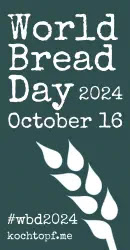Since I wasn't a member of the group at that time, and (hopefully) my breadmaking skills had improved, I looked forward to giving this recipe a try.
The dough doesn't appear to rise very much during the proofing process, and it is fairly wet and slack. There were multiple cautions about over-proofing, so, I suspect, at times, I didn't proof it long enough. To preserve the hole, I placed a greased, glass custard cup in the middle. I proceeded as directed up until the end, when there were multiple flipping tasks. In fear of totally deflating the dough, I didn't do the last flip. And, even though I did my best to score the top, I just couldn't get the cuts deep enough.
But, here it is. It turned out decently, with a nice texture and good flavor.
It's definitely worth baking. Perhaps the dough is more forgiving than it appears!
Royal Crown's Tortano Bread
Time Required for Recipe: About 19 hours, with about 20 minutes of
active work
The Evening Before Baking: Make the starter and if you like the mashed potato.
The Next Morning: Mix the dough and let it ferment for about 4 hours. Shape it, proof it for about 1 1/2 hours, and then bake the bread for about 45 minutes.
The Evening Before Baking: Making the Pre-Ferment:
The Next Morning: Mix the dough and let it ferment for about 4 hours. Shape it, proof it for about 1 1/2 hours, and then bake the bread for about 45 minutes.
The Evening Before Baking: Making the Pre-Ferment:
Ingredients Metric
1/4 tsp instant yeast
1 cup water 105 - 115 degrees F
100 grams unbleached bread flour
85 grams small potato
1/4 tsp instant yeast
1 cup water 105 - 115 degrees F
100 grams unbleached bread flour
85 grams small potato
Stir the yeast into the water in a glass measure and let it stand for 5
- 10 minutes. Add 1/3 cup of this yeasted water (discard the rest) to the flour
and beat this very sticky starter until it is well combined. Cover with plastic
wrap and let it ferment until it is full of huge bubbles and sharp tasting,
about 12 hours. If your kitchen is very warm and the pre-ferment is fermenting
very quickly, place it in the refrigerator after 3 hours of fermenting. In the
morning, remove it and allow it to come to room temperature 30 minutes to an
hour before beginning the final dough
Preparing the Potato: For efficiency, you may want to prepare the potato the night before. Quarter it, then boil it in water to cover until it can be easily pierced with a knife tip, about 20 minutes. Drain; if desired, reserve the water for the dough. Press the potato through a ricer or sieve to puree it and remove the skin. Store it in a covered container in the refrigerator. You will need only 1/4 cup puree.
Bake Day: Mixing the Dough
Ingredients Metric
575 grams unbleached bread flour
420 grams Water, including the potato water if desired, lukewarm
Pre-ferment
14 grams honey
60 grams Potato puree
15 grams salt
Preparing the Potato: For efficiency, you may want to prepare the potato the night before. Quarter it, then boil it in water to cover until it can be easily pierced with a knife tip, about 20 minutes. Drain; if desired, reserve the water for the dough. Press the potato through a ricer or sieve to puree it and remove the skin. Store it in a covered container in the refrigerator. You will need only 1/4 cup puree.
Bake Day: Mixing the Dough
Ingredients Metric
575 grams unbleached bread flour
420 grams Water, including the potato water if desired, lukewarm
Pre-ferment
14 grams honey
60 grams Potato puree
15 grams salt
By Stand Mixer: With your hands or a wooden spoon, mix the flour and water into a rough, very wet dough in the work bowl of your mixer. Cover the dough and let it rest (autolyse) for 10 - 20 minutes.
Fit the mixer with the dough hook. Add the pre-ferment, honey, potato and salt and the mix the dough on medium speed for 15 - 20 minutes, or until very silky and wraps around the hook and cleans the bowl before splaterring back around the bowl. This dough is almost pourably wet.
Fermenting and Turning the Dough:
Shape the dough into a ball and roll it in flour. Place it in a container at least 3 times its size and cover tightly with plastic wrap. Let it ferment until doubled in bulk and filled with large air bubbles, about 4 hours. Using plenty of dusting flour, turn the dough 4 times in 20 minute intervals, that is, after 20, 40, 60, and 80 minutes of fermenting, the leave the dough undisturbed for the remaining time. Do not allow this dough to over ferment or ferment to the point of collapse, for the flavor and structure of your bread will suffer.
Shaping and Proofing the Dough:
Turn the fermented dough out onto a well floured work surface, round it and let it rest for 20 minutes. Sprinkle a couche or wooden board generously with flour. Slip a baking sheet under the couche if you are using one for support.
Sprinkle a generous amount of flour over the center of the ball. Push your fingers into the center to make a hole, the rotate your hand around the hole to widen it, making a large 4 inch opening. The bread should have about 12 inch diameter.
Place the dough smooth side down on the floured couche or board and dust the surface with more flour. Drape it with plastic wrap and let it proof until it is light and slowly springs back when lightly pressed, about 1 1/2 hours.
Preheating the Oven:
Immediately after shaping the bread, arrange a
rack on the oven's second to top shelf and place a baking stone on it. Clear
away all the racks above the one being used. Preheat the oven to 450 degrees
(230 C)
Baking the Bread:
Unwrap the bread and flip it onto a floured peel or a
sheet of parchment paper. Do not worry about damaging the bread as you handle
it; it will recover in the oven as long as it is not overproofed. Slash it with
4 radial cuts in the shape of a cross. Slide the loaf onto the hot baking stone
and bake until it is very dark brown, 40 -50 minutes, rotating it halfway into
the bake. Let the bread cool on a rack.
To be a Buddy, bake the bread and tell your story by the end of the month.
Happy anniversary to all the Babes!
- Blog from OUR Kitchen – Elizabeth
- A Messy Kitchen – Kelly
- Karen’s Kitchen Stories – Karen
- Notitie Van Lien – Lien
- My Diverse Kitchen - Aparna
- Bread Experience - Cathy
- Thyme for Cooking - Katie
- My Kitchen in Half Cups - Tanna
- Bake My Day - Karen
- Feeding My Enthusiasms - Elle








